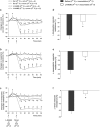Central blockade of nitric oxide synthesis reduces moxonidine-induced hypotension
- PMID: 15172964
- PMCID: PMC1575058
- DOI: 10.1038/sj.bjp.0705853
Central blockade of nitric oxide synthesis reduces moxonidine-induced hypotension
Abstract
1. Nitric oxide (NO) and alpha(2)-adrenoceptor and imidazoline agonists such as moxonidine may act centrally to inhibit sympathetic activity and decrease arterial pressure. 2. In the present study, we investigated the effects of pretreatment with l-NAME (NO synthesis inhibitor), injected into the 4th ventricle (4th V) or intravenously (i.v.), on the hypotension, bradycardia and vasodilatation induced by moxonidine injected into the 4th V in normotensive rats. 3. Male Wistar rats with a stainless steel cannula implanted into the 4th V and anaesthetized with urethane were used. Blood flows were recorded by use of miniature pulsed Doppler flow probes implanted around the renal, superior mesenteric and low abdominal aorta. 4. Moxonidine (20 nmol), injected into the 4th V, reduced the mean arterial pressure (-42+/-3 mmHg), heart rate (-22+/-7 bpm) and renal (-62+/-15%), mesenteric (-41+/-8%) and hindquarter (-50+/-8%) vascular resistances. 5. Pretreatment with l-NAME (10 nmol into the 4th V) almost abolished central moxonidine-induced hypotension (-10+/-3 mmHg) and renal (-10+/-4%), mesenteric (-11+/-4%) and hindquarter (-13+/-6%) vascular resistance reduction, but did not affect the bradycardia (-18+/-8 bpm). 6. The results indicate that central NO mechanisms are involved in the vasodilatation and hypotension, but not in the bradycardia, induced by central moxonidine in normotensive rats.
Figures


Similar articles
-
Antihypertensive responses elicited by central moxonidine in rats: possible role of nitric oxide.J Cardiovasc Pharmacol. 2006 Jun;47(6):780-7. doi: 10.1097/01.fjc.0000211794.68152.04. J Cardiovasc Pharmacol. 2006. PMID: 16810079
-
Involvement of central alpha1- and alpha2-adrenoceptors on cardiovascular responses to moxonidine.Eur J Pharmacol. 2007 Jun 1;563(1-3):164-71. doi: 10.1016/j.ejphar.2007.02.002. Epub 2007 Feb 16. Eur J Pharmacol. 2007. PMID: 17382316
-
Commissural nucleus of the solitary tract regulates the antihypertensive effects elicited by moxonidine.Neuroscience. 2013 Oct 10;250:80-91. doi: 10.1016/j.neuroscience.2013.06.065. Epub 2013 Jul 10. Neuroscience. 2013. PMID: 23850502
-
Central moxonidine on salivary gland blood flow and cardiovascular responses to pilocarpine.Brain Res. 2003 Oct 17;987(2):155-63. doi: 10.1016/s0006-8993(03)03322-5. Brain Res. 2003. PMID: 14499959
-
Acute intravenous injection and short-term oral administration of N(G) -nitro-L-arginine methyl ester to the rat provoke increased pressor responses to agonists and hypertension, but not inhibition of acetylcholine-induced hypotensive responses.Fundam Clin Pharmacol. 2011 Jun;25(3):333-42. doi: 10.1111/j.1472-8206.2010.00852.x. Fundam Clin Pharmacol. 2011. PMID: 20608990
Cited by
-
Central modulation of cyclosporine-induced hypertension.Naunyn Schmiedebergs Arch Pharmacol. 2015 Mar;388(3):351-61. doi: 10.1007/s00210-014-1074-1. Epub 2014 Nov 29. Naunyn Schmiedebergs Arch Pharmacol. 2015. PMID: 25430438 Review.
-
Facilitation of central imidazoline I(1)-site/extracellular signal-regulated kinase/p38 mitogen-activated protein kinase signalling mediates the hypotensive effect of ethanol in rats with acute renal failure.Br J Pharmacol. 2009 Nov;158(6):1629-40. doi: 10.1111/j.1476-5381.2009.00444.x. Epub 2009 Oct 20. Br J Pharmacol. 2009. PMID: 19845670 Free PMC article.
-
Moxonidine: a review of its use in essential hypertension.Drugs. 2006;66(4):477-96. doi: 10.2165/00003495-200666040-00006. Drugs. 2006. PMID: 16597164 Review.
-
Imidazoleacetic acid-ribotide in vestibulo-sympathetic pathway neurons.Exp Brain Res. 2016 Oct;234(10):2747-60. doi: 10.1007/s00221-016-4725-2. Epub 2016 Jul 13. Exp Brain Res. 2016. PMID: 27411812 Free PMC article.
-
Vestibular neurons with direct projections to the solitary nucleus in the rat.J Neurophysiol. 2019 Aug 1;122(2):512-524. doi: 10.1152/jn.00082.2019. Epub 2019 Jun 5. J Neurophysiol. 2019. PMID: 31166818 Free PMC article.
References
-
- BARMAN S.M., GEBBER G.L. Basis for the naturally occurring activity of rostral ventrolateral medullary sympathoexcitatory neurons. Prog. Brain Res. 1989;81:117–129. - PubMed
-
- CALVER A., COLLIER J., VALLANCE J. Nitric oxide and cardiovascular control. Exp. Physiol. 1993;78:303–326. - PubMed
-
- COLOMBARI E., DAVISSON R.L., SHAFFER R.A., TALMAN W.T., LEWIS S.J.Hemodynamic effects of L-glutamate in NTS of conscious rats: a possible role of vascular nitrosyl factors Am. J. Physiol. 1998274H1066–H1074.(Part 2) - PubMed
-
- DOBRUCKI L.W., CABRERA C.L., BOHR D.F., MALINSKI T. Central hypotensive action of clonidine requires nitric oxide. Circulation. 2001;104:1884–1886. - PubMed
-
- ERNSBERGER P., ELLIOT H.L., WEIMAN H.J., RAAP A., HAXHIU M.A., HOFFERBER E., LOW-KROGER A., REID J.L., MEST H.J. Moxonidine: a second-generation central antihypertensive agent. Cardiovasc. Drug. Rev. 1993;11:411–431.
Publication types
MeSH terms
Substances
LinkOut - more resources
Full Text Sources
Medical

